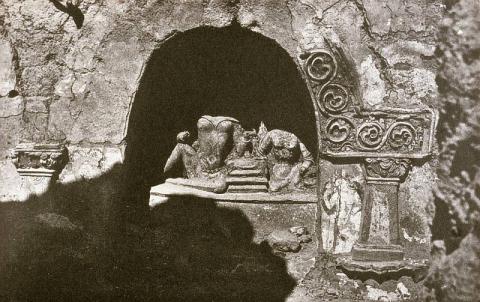Fondukistan is a Buddhist site in the Ghorband valley (Parvan province, Afghanistan), c. 120 km north-west of Kabul. It is located on the top of a hill overlooking the valley from the south, a bit north of the route that passed through the Hindukush, once connected India to Bactria and Central Asia.
First mentioned by the English explorer Charles Masson in 1836, the site was excavated by the Délégation Archéologique Française en Afghanistan (DAFA) in 1937, under the direction of Jean Carl. The posthumous publication of the site, in 1959, is based on the brief notes and the incomplete description left by Carl and Joseph Hackin.
This relatively small complex displays elements of great interest with regard to the history of Buddhist art and patronage. The cultic area, which is connected with other structures possibly associated with monastic life, is a square mud-brick building housing in its centre a stūpa made of schist with square base. The overall design of the structure and decoration, whatever the stages and length of realization, seems to have followed a unified concept. Twelve wall niches, framed by an architectural decoration in relief that reproduced a continuous row of arches, contained groups of polychrome and gilded sculptures with different subjects. The most common compositional pattern was two minor characters converging towards a larger, main figure in the centre. Other minor figures, some of them emerging half-length from drapes on the upper part of the walls, emphasized the liveliness of the scenes, which is already masterly conveyed by the fluidity of the body masses, the expressiveness of the faces and gracefulness of gestures.
Standing out from the overall context of sacred icons is the famous “princely couple” from Niche E (Fig. D). The two figures – the princess in “Indian” dresses, the prince wearing a rich caftan with double lapel and boots – are represented symmetrically and frontally, sitting to either side of a pile of cushions on which they each prop one elbow. Two cinerary urns were found inside the base, all evidence pointing to the princely donors of the portrait sculptures. One of the urns contained a coin of the Sasanian king Khusro II (591–628) which had been countermarked by an Arab governor in 689. This mark offers a valuable clue for dating the sculptures or, at least, the funerary deposit, as it must have been buried after this date.
The decoration of the sanctuary was completed by mural paintings, both inside and outside the niches. The painted figures – among which an image of Maitreya and the personified pair of Sun and Moon – show the same slenderness, gracefulness and bright coloration as the sculptures.
Stylistic comparisons with contemporaneous works in Afghanistan, such as the sculpture of the late phases of Tapa Sardar and the second phase of painting at Bamiyan, and with Tumshuq in Central Asia, the sculpture of Ushkar in Kashmir, and vague affinities with coeval bronze sculpture in Pakistan give witness to a common artistic culture that, albeit with regional variants, in the 7th–8th century CE was shared in a vast territory stretching from Eastern Central Asia to the north-western regions of the Indian Subcontinent. .


_geschn_0.png%3Fitok=XJHqbGrW)